Level Up Your Marketing Translations
Find vetted experts in marketing translation and localization, keep projects organized, automate payments, even delegate entire projects to experts in translation project management.
These Industry Leaders Trust Traduality with their Multilingual Projects











Marketing Translations Into Any Language, Any Time
Cut down on the time it takes to find and qualify translators for marketing translation. Traduality’s marketplace exclusively features professional marketing translators and transcreators who have successfully passed our rigorous vetting process.
Delegate Your Translation Projects
Choose between self-service or delegating entire projects to Traduality:
- Translate faster and decrease burnout for your bilingual employees by delegating the translation process.
- Work with expert project managers with experience in language operations to obtain the highest quality.
- Incorporate cutting-edge translation technologies with no effort to speed turnaround times.


"The interpreters and technical support who worked with our organization provided an excellent service to the members and guests who joined our webinar. They were efficient and clear, and we able to adjust to any technical difficulties that we faced. They were also friendly."

"Traduality did amazing work for us! They were accurate with their translation and delivered on time."

"Always prompt and friendly replies, and delivered on time! Thorough feedback and answers when requested. Would definitely recommend working with this team for Spanish needs! Traduality is my go-to vendor for Mexican Spanish."
Streamline Project Management
Invite your employees to run projects from one platform. With Traduality, you can:
- Keep projects organized in a list or Kanban views.
- Collaborate with translators across projects easily.
- Delegate to Traduality or keep complete control of your translation projects.
Traduality Has the Perfect Marketplace for Marketing Translations
Improve Turnaround
Share files, engage in Q&A, and even store invoices inside projects.
Reduce Search Times
Access vetted language experts in translation, localization, interpretation, subtitling, and more.
Enhanced Organization
Keep your projects organized in list or Kanban views on the project dashboard.
Improve Relations
Issue payments in up to 60 days. Translators get paid within 15 days.
In-House Collaboration
Collaborate with your employees using the same platform.
Increase Project Quality
All translators selling services in the platform are experts in professional translation.
Start using Traduality Free
Find vetted linguists faster, while keeping projects organized.
Marketing Translation: Everything You Need to Know
We all know that translation services are important— they give us new avenues to communicate and share art, music, and ideas— but how does translation work in the marketing industry? Although you may not even notice it, marketing translation plays a massive role in our lives, and here’s how:
What is Content Translation?
To start, let’s talk about content translation. Content translation involves translating and localizing existing content to fit a new language model while attracting the same target audience. Blogs, whitepapers, advertisements, web copy, and video content are all available mediums for content translation. The key aspect here is that while the language of your content may change, its message and intended audience will stay the same.
Why is Content Translation Important?
Content translation is necessary because it spreads your business’s ideas to an international audience. While a large portion of the world may speak your native language, millions of others don’t. If you want to attract others from around the world, your content must be digestible for them.
For example, suppose you’re looking to spread the word about new, groundbreaking medical equipment. In that case, your whitepaper must be available in multiple languages so doctors worldwide can access it. Of course, each version of your document will also need localization to ensure that it makes sense in each target language.
Examples of Content Translation
Still trying to understand content translation and localization? You can check out some examples of content translation via our case studies.
Examples of Commercial Translation
Like content translation, commercial translation includes blogs, whitepapers, web copy, and videos. However, commercial translation revolves around a business’ proceedings and messages to customers and employees. For example, a business may need to translate and localize a training video for another branch, or they may need to localize content for newsletters.
Here are some other examples of commercial translation in action:
Examples of Translation Techniques
Overall, there are three techniques translators use for content. Each has its own bonuses and drawbacks:
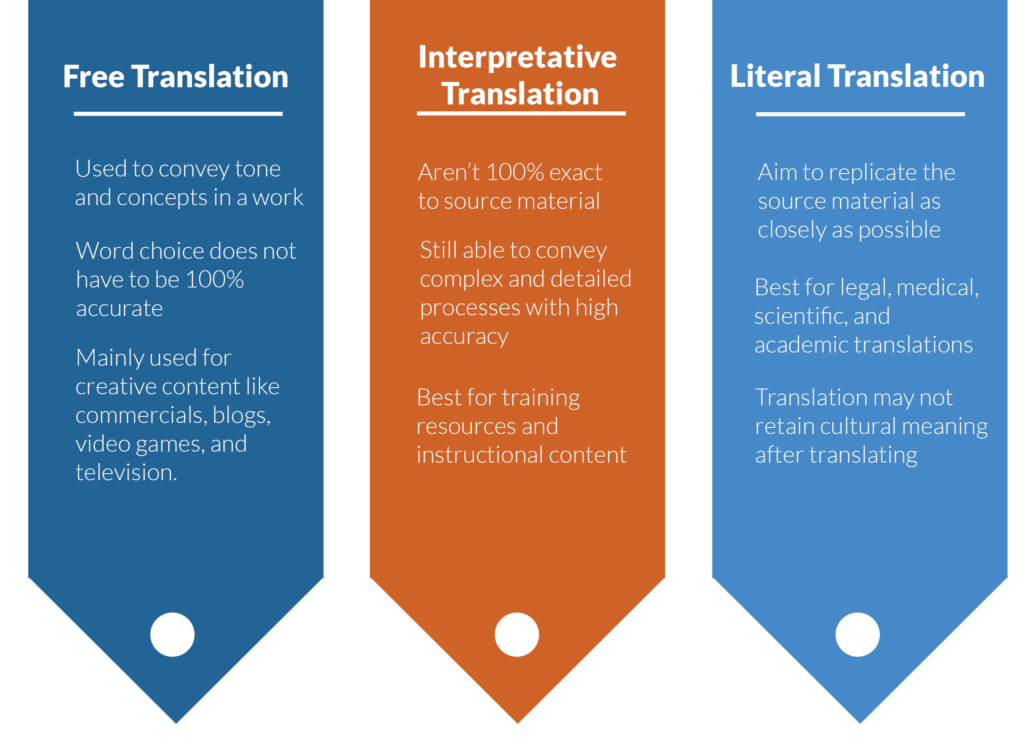
- Literal Translations aim to replicate the source material as closely as possible in the translated version. Literal translations are ideal for legal, medical, scientific, and academic documents.
- Interpretive Translations aren’t exact to the source material but close enough to fully convey complex ideas and instructions to audiences. Training videos, handbooks, guides, and news articles are often translated this way.
- Free Translations convey the tone and concepts of a work but don’t always stay close to the source’s original wording. Commercials, video games, and other highly creative media are often given this treatment.
What are the Four Most Common Types of Translation?
Translation is a massive field covering a wide array of mediums, from literature to video games, safety labels, and even logo design. Generally speaking, though, four fields of translation are more common than others. The four most common types of translation are:
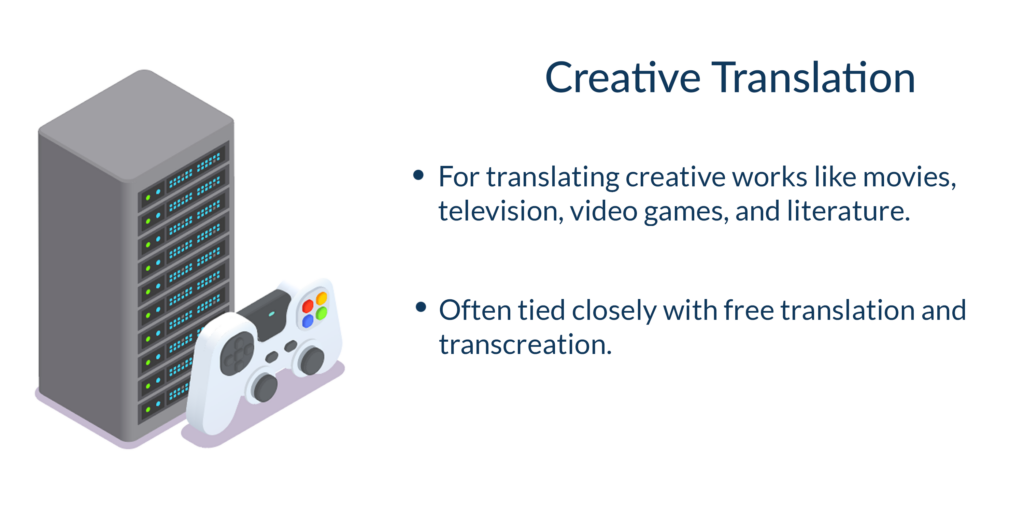
- Creative Translation. This field includes translating and interpreting books, films, video games, and other art pieces.
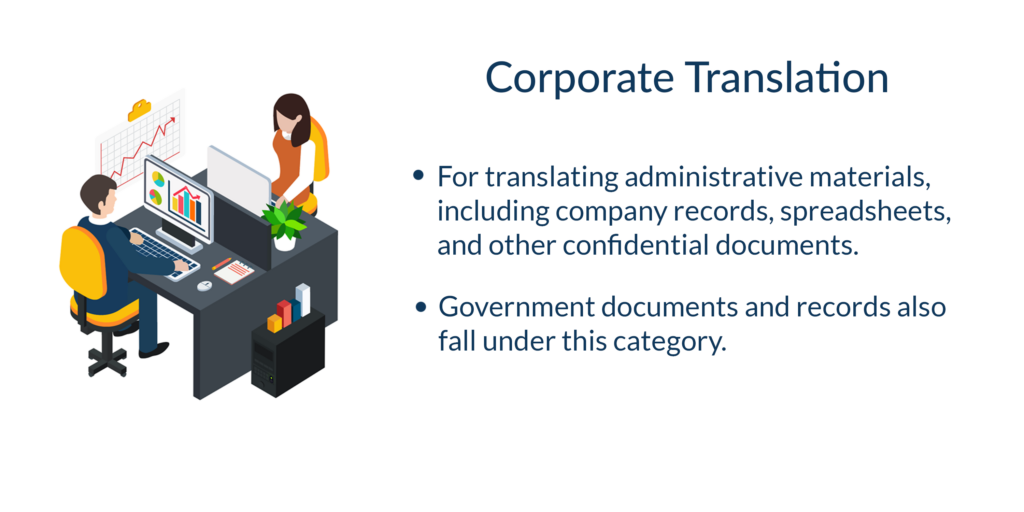
- Corporate Translation is the translation of professional and business materials.
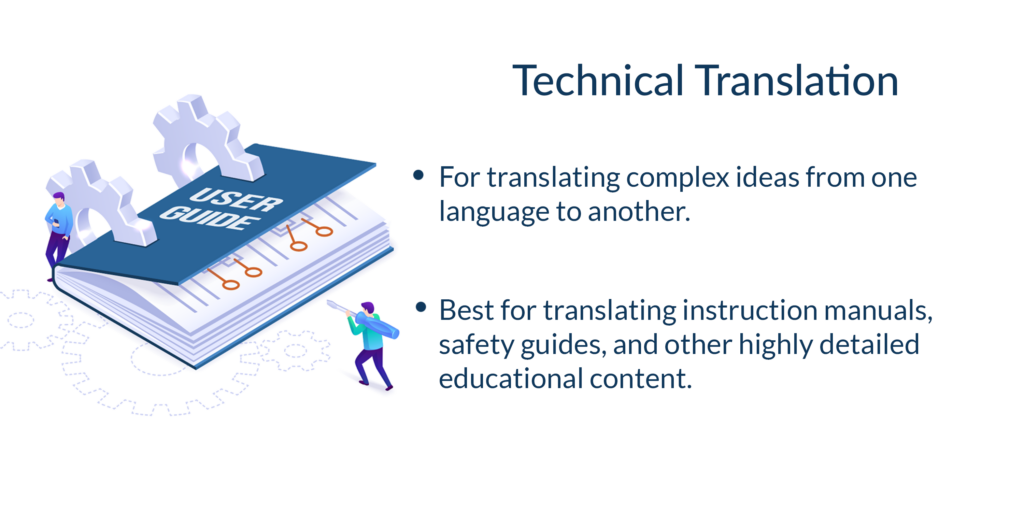
- Technical Translation involves translating and localizing technical pieces, like instruction manuals and guidebooks.
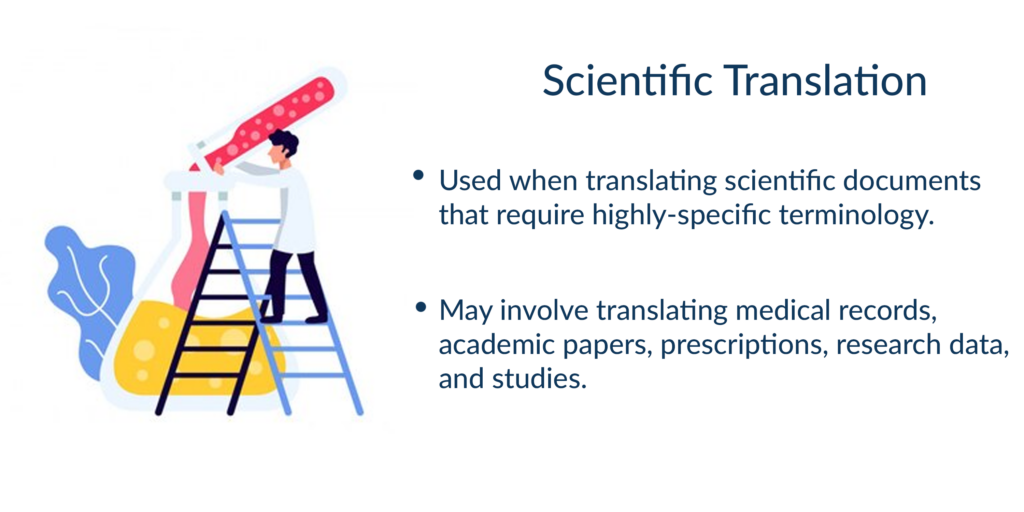
- Scientific Translation includes translating research data, academic papers, and medical information.
What is Marketing Translation?
So, where does marketing translation fit into all of this?
Marketing translation typically falls into the “professional” category of translation services; as the translation and localization of marketing materials, the field of marketing translation plays a considerable role in international advertising and marketing. It’s how your company spreads to a broader audience around the world.
Marketing Translation Examples
You’ll most often encounter marketing translation in advertisements. Ads are a significant marketing tool; if an ad goes viral, a business will likely translate it for other audiences. For example,
You’ll also find marketing translation on a business’ webpage. Large companies often have digital storefronts and landing pages in various languages to appeal to a larger customer base.
Marketing Translation in Spanish
In the United States, Spanish is the second most common language spoken among residents (the first being English). With such a large percentage of the population knowing Spanish on a native level, many businesses will include Spanish translations alongside English content.
Road signs, operator services, and even government websites will often have options for those who natively speak Spanish as an alternative.
What is Marketing Content Translation?
Marketing content translation is exactly what it says on the tin: a team of translators works to translate marketing content. Advertisements, blog posts, web copy, and other related media all fall under the “marketing content translation” umbrella.
What are Translation Marketing Agencies?
A marketing translation agency specializes in translating marketing materials. While these agencies can specialize in a variety of translation mediums, they all focus on marketing content.
What is SEO Content Translation?
Search engine optimization is the process of researching and implementing keywords, backlinks, and other resources into your webpage to establish credibility and look good to search engines. When someone looks something up online, their search engine crawls around the internet, looking for websites that best fit the search query. The closer the fit, the higher the site ranks on the search results page.
Translating your marketing content sounds great, but how do you get people to see it? Your original pieces are already optimized for search engines, but what about the new stuff?
That’s where SEO content translation comes in.
SEO content translation is what marketing translators implement to ensure that a business’ content maintains its search ranking while staying accurate to the source material.
Why does SEO Translation Matter?
SEO translation matters because, like traditional SEO, your content won’t appear unless optimized for web crawlers. Traditional SEO best practices like keyword research and integration are vital to establishing your website’s credibility and ranking on various search engines— don’t let your website fall short just because it’s only optimized in one language!
What are the Benefits of SEO Translation?
SEO translation is essential for businesses looking to expand to multilingual audiences, as it keeps your content relevant in the eyes of the target language’s search engines. Not only does optimizing translated content keep it relevant for Google, but it also:
- Provides native speakers with a more genuine search experience.
- Develops effective content in a variety of languages.
- Improve your rankings for terms users actually search for.
What is SEO-Friendly Translation?
You don’t have to create new content in your target language to improve your site’s SEO. Instead, try implementing SEO-friendly translation. An SEO-friendly translation aims to translate your original content as closely as possible while retaining its coherence and tone. In addition, this kind of content translation leaves room for your translation team to weave relevant keywords in the target language.
How do I Translate SEO Keywords?
Translating and localizing a piece for SEO keywords will take a while, but the process is well worth the effort. To start, you’ll need to create a list of all the keywords and long-tail keywords in your source material. After translating (and localizing) these keywords, the next step is to determine which ones are viable for your SEO strategy— are people searching these terms? If not, you’ll have to refine your keywords to better fit the target language’s search patterns.
Transcreation vs. Translation
Chances are, you’ve probably heard some marketing horror stories, like the blunder KFC China made with its slogan. As it turns out, “eat your fingers off” is not a good way of saying your chicken is “finger-lickin’ good.”
What is Transcreation?
It’s times like these where transcreation comes in. Sometimes, your translations can only go so far— discrepancies between the source and target languages can confuse audiences. Perhaps you’ve got a phrase that makes no sense in a target language. Or your international audience may not understand a specific joke. Transcreation aims to bridge these gaps in coherence by translating a work as closely as possible while prioritizing the source material’s tone, message, and creative vision.
How is Transcreation Different from Translation?
Unlike translation, transcreation requires an additional level of creativity, especially when localizing content like movies, books, and video games. While the translation process focuses on maintaining fidelity to the source material, transcreation emphasizes maintaining the source material’s tone, intent, and emotional impact.
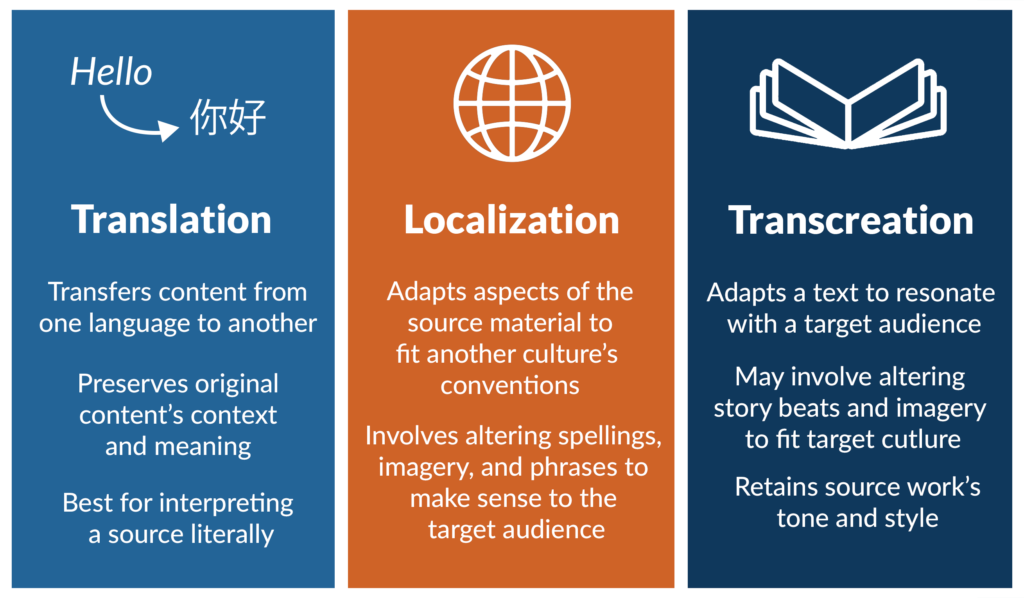
Is a Transcreation a Translation?
You may wonder: by this definition, wouldn’t translation and transcreation be the same?
The answer is yes and no. Translation is a crucial component of the transcreation process. Transcreation takes a translated work a step further to hone in on the artist’s intentions for a work while keeping it accessible to audiences in the target language.
Examples of Transcreation
If you’re a fan of video games, you’ve most likely seen transcreation in action. When companies like Nintendo or Microsoft localize their games for international sale, they may change certain words, phrases, or objects to spread their message more easily among international audiences. For example, the Pokemon franchise often changes its flavor text quite a bit. In the Sinnoh games, a story in the Canalave Library originally mentioned how people used to marry their Pokemon. The English version changed this to describe how people would eat meals alongside their Pokemon instead.
Transcreation in Literature
In the literary world, you’ll find transcreation in the classics: The Epic of Gilgamesh, Don Quixote, Les Miserables, and even prolific philosophical works like The Art of War and The Communist Manifesto are all available in dozens of languages.
Transcreation in Marketing
Every aspect of marketing requires translation or transcreation in some way. For example, you need to create packaging in Spanish for your product— you can’t just slap the English ingredients label on the back! You’ll need to translate the ingredients. From there, you might as well replace the slogan on the front of your packaging to make sense in Spanish, too.
Website Transcreation
International websites require transcreation services to provide all visitors with the best user experience, regardless of their native language. For example, massive social media platforms like Facebook and TikTok implement transcreation constantly— for their ads, web copy, and video content. Some sites, like Twitter, allow users to auto-translate tweets as well, allowing users to bypass language barriers.
Companies with individual sites may also implement transcreation practices when designing web copy for new landing pages. When visitors click on the link to the website, it will determine which language to access based on the user’s set language in their web browser.
Transcreation in Film
The film and television industry plays a massive role in the transcreation industry. Dubbed media, like cartoons and anime, are often transcreated into a target language to better resonate with the language’s target audience. For example, Disney and Studio Ghibli films will feature new scripts for dubbed content, alongside minor edits to the animation and backgrounds, to create less cultural confusion among audiences. Next time you watch an animated film, check the signs and logos in the background— they may vary from dub to dub!
Certified Translations
Certified translations are vital for documents that will be used for specific government processes like getting a driver’s license, working or studying abroad, immigration requirements, or legal trials. Not all translated materials require them, and having a certified translation does not indicate higher quality.
What is a Certified Translation?
In the United States, a certified translation is a translation that has been signed by its translator, usually in the form of an affidavit detailing that the translation is accurate to the original document. In other countries like Mexico, there are official translations, instead of certified translations, that require a stamp issued to translators authorized by the local government to certify translations; some European countries like Germany require a notarized translation instead, which are explained further below. Regardless of their different names, whether a translation is certified, official, or notarized, they often fulfill the same purpose: providing a government entity, public, or private institution confirmation that an impartial translator with professional credentials translated the original content.
What is Considered a Certified Translation?
According to the American Translator’s Association, any translated work is considered “certified” if it contains a statement that includes:
- The translator’s name, qualifications, and background.
- The name of the translated work and the language it was translated into.
- A note that confirms the translation is complete and accurate.
- The translator’s signature and date of certification.
Do all Translations Need Certification?
In short, no; only some translations need certification to be considered accurate. The certification adds an extra layer of credibility to a translated work. Translation projects like web copy, blog posts, video subtitles, or video game text don’t usually require a certification document. However, government institutions like USCIS and the DMV may require certified or notarized translations.
What is the USCIS?
For those unaware, the United States Citizenship and Immigration Services is a department within the US government that oversees the immigration process. When someone emigrates to the United States, they’ll need to go through USCIS to enter the country legally. USCIS also oversees the citizenship process, the distribution of work visas, genealogy studies, and international adoption processes.
What is a Certified Translation for USCIS?
The United States Citizenship and Immigration Services often requires evidence to support a potential citizen’s case. Documents like birth certificates, tax statements, and academic transcripts are essential for these cases and will thus need translation for USCIS to approve. USCIS requires all non-English documents to come with a certified translation counterpart.
USCIS Translation Requirements
According to federal regulations, USCIS requires any submitted documents that contain languages other than English to accompany a full-English, certified translation. So, if you have any documents in a language other than English, you’ll need to submit a certified translation of the document alongside the original. Materials like birth certificates, passports, and academic transcripts are just a few things you’ll need a complete English translation for.
What if I Have a Document in More Than One Language?
If you’ve got documents in more than one language that need to go to the USCIS, it’s best to create full English translations of them as well.
What is the Difference Between a Notarized Translation and a Certified Translation?
Since any translator can certify a translation (even if it’s their own), how do we ensure that legal documents maintain their extra level of security?
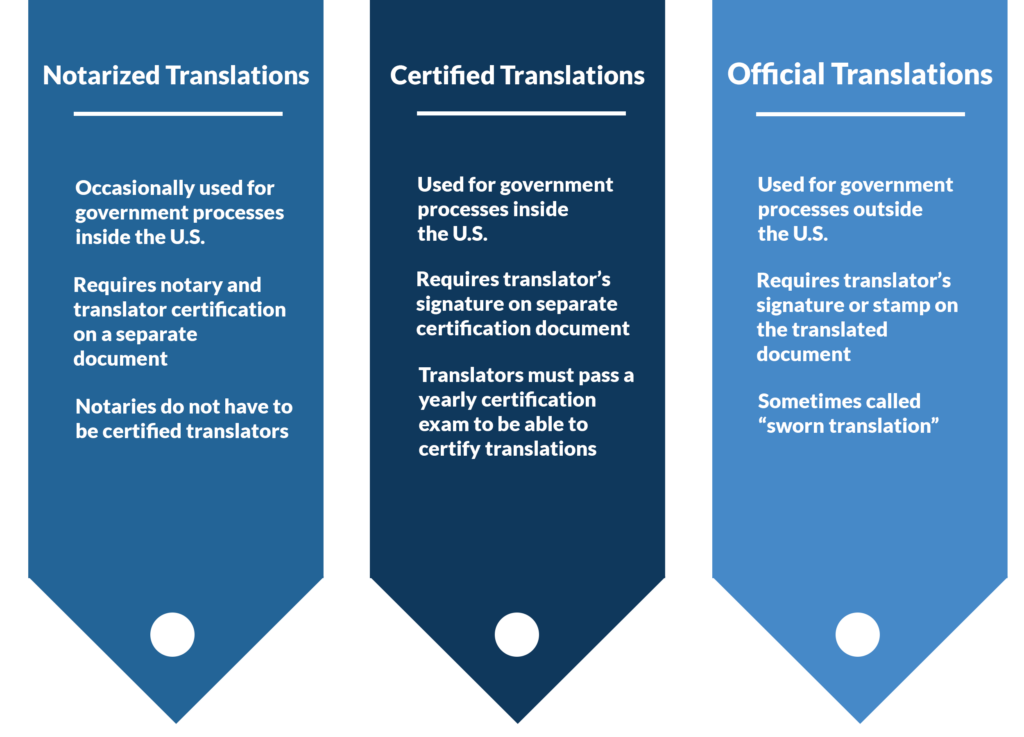
Notarized translations, unlike certified translations, require the presence of a legal notary when certifying the work. While the notary most likely won’t look over the translation to ensure accuracy, they exist to affirm the translator’s identity and qualifications.
How do I Get a Certified Translation?
To create a certified translation, you’ll first need to hire a translator. When you discuss the terms of your project, you can request that they certify their translation at the end of the process. To request a notarized translation, you’ll need to contact a notary and schedule a time for signing the certification statement. Get in touch if you need a notarized translation— we’ve got you covered!
The American Translator’s Association
Better known as the ATA, the American Translator’s Association is a volunteer organization that aims to bring translators and interpreters together. Like a trade guild, the ATA facilitates communication, organizes events, and provides opportunities for translators and interpreters nationwide. The ATA also has its own certification seal that its members can use.
What does the American Translator’s Association Do?
According to its Mission Statement, the ATA’s goal “is to promote the recognition of professional translators and interpreters, to facilitate communication among its members, to establish standards of competence and ethics, to provide its members with professional development opportunities, and to advocate on behalf of the profession.”
In other words, the organization acts as a union for translators and interpreters— it provides them with work opportunities and a specific list of best practices to follow.
The American Translator’s Association’s leading service is the ATA Certification Exam, a test that, when passed, awards translators with the highest level of recognition for their competence as translators. The ATA Certification Exam comes in a variety of languages and language combinations.
What is a Marketing Translator?
The realm of content translation is pretty fascinating, right? But what if you want to get into translation?
For the aspiring translator, marketing translation is one of the best fields to delve into. As we mentioned earlier, marketing translation involves translating and localizing marketing materials. Marketing translators are the ones who complete the translation process for their clients.
What Does a Marketing Translator Do?
Marketing translators don’t necessarily specialize in a particular medium or type of translation. Instead, they work across a wide breadth of mediums in various styles. For example, a marketing translator may work on one project that requires SEO translation for a blog post and another where they translate a script for the voiceover in an advertisement. Some marketing translators may need to delve into transcreation when developing slogans or campaigns that match their client’s original tone and intent.
How Much Do Translators Get Paid?
Cost plays a significant role in translation and may determine a project’s scope and services. However, a translator’s salary may change based on the scope of a project and the services required to complete it. Generally speaking, a freelance translator usually gets paid between $.05 and $.15 per word for translations, $50-$150 an hour for interpreting services, and $7-$20 per minute for video subtitles. These rates vary significantly because translation isn’t a cut-and-dry process. A translator’s rates will always change based on the project’s complexity, the combination of languages required, and the demand for translators specializing in a specific language. For example, translators specializing in languages like English and Spanish are easier to find than those specializing in Dutch or Norwegian.
Transcreation Rates
For example, a project that requires transcreation services will generally cost more than just translation. Since the transcreators will need to spend more time copywriting, editing, and refining original content to fit the source material’s tone and intent, expect to pay more for a different, sometimes additional, service.
Transcreation prices once again vary based on the transcreator’s experience as well as the scope of the project. However, there is no transcreation rate per word. Instead, most translators and transcreators charge per hour.
Ready to get started on your next translation project? Traduality has everything you need to succeed; create your first project today and find vetted translators, or book a meeting with us to learn more about your specific needs.
Updated 2/21/2024.

